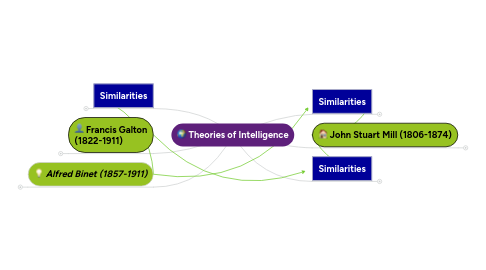
1. Similarities
1.1. Both studied associationist theory
2. Similarities
2.1. Both came from wealthy families
2.2. Both had evidence of multi potentiality
2.3. Both had emotional breakdown
2.4. Both died in 1911
3. Francis Galton (1822-1911)
3.1. Views
3.1.1. Nativistic Psychology based on hereditary factors
3.1.1.1. Based on Darwin's Theory of Evolution
3.1.1.2. differences in ability & character are innate
3.1.2. Mental Heredity
3.1.2.1. Mental peculiarities of different races
3.1.2.2. ability occurs by descent
3.1.3. Research
3.1.3.1. Adoptive family method
3.1.3.2. Twin study method
3.1.4. Developed Science of Eugenics
3.1.4.1. Goals
3.1.4.1.1. Development of intellectually & psychologically superior human being
3.1.4.1.2. Institution of customs & laws to ensure proliferation in order to dominate society
3.1.4.2. First to introduce idea of the intelligence test
3.1.5. Believed precise scores & numbers could capture psychological characteristics
3.2. Life Work
3.2.1. Hereditary Talent & Genius (1865)
3.2.2. Hereditary Genius (1869)
3.2.3. The History of Twins,as a Criterion of the Relative Powers of Nature and Nurture (1875)
3.2.4. Memories of My Life (1908)
4. Alfred Binet (1857-1911)
4.1. Father of the IntelligenceTest
4.1.1. Views
4.1.1.1. Associationist psychology
4.1.1.1.1. Influenced by John Stuart Mill
4.1.1.2. Intelligence could not be isolated from experience
4.1.1.3. Individual psychology
4.1.1.4. Believed precise scores & numbers could not capture psychological characteristics
4.1.2. Life Work
4.1.2.1. Much of Binet's work remains untranslated
4.1.2.1.1. The Experimental Psychology of Alfred Binet: Selected Papers (1969)
4.1.2.1.2. The Development of Intelligence in Children (The Binet Simon Scale) (1973)
5. John Stuart Mill (1806-1874)
5.1. Views
5.1.1. Associationistic Psychology based on environmental factors
5.1.1.1. Three Basic Laws
5.1.1.1.1. Law-association by similarity
5.1.1.1.2. Law-law of Intensity
5.1.1.1.3. Law-Association by Contiguity
5.1.2. mental chemistry
5.1.2.1. complex ideas
5.1.2.1.1. sense of conscience and moral sentiments
5.1.2.1.2. space and time
5.1.3. innate factors
5.1.3.1. some instincts
5.1.4. Developed Science of Ethology
5.2. Life Work
5.2.1. A System of Logic (1843)
5.2.2. An Analysis of the Phenomena of the Human Mind
5.2.3. Principles of Political Economy (1848)
5.2.4. The Subjection of Women (1869)
